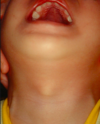Condition- Thyroglossal Cysts Flashcards
(9 cards)
What structure does the thyroid develop from?
The floor of the pharynx- the foramen cecum
What is the thyroglossal duct?
It is an embryological remnant of the path of the thyroid’s descent from the floor of the pharynx to its normal position during development.
What is a thyroglossal cyst
Remaining thyroglossal duct tissue which should have atrophied in the 6th week after the descent of the thyroid from the pharynx to the neck.
Which age group often presents with thyroglossal cysts?
CHILDREN and ADOLESCENTS (because it’s an embyrological remnant)
List some of the presenting symptoms of someone with a thyroglossal cyst
- A swelling/lump is noticed in the midline of the anterior neck
- Usually ASYMPTOMATIC
- May be tenderness or rapid enlargement due to infection
Describe the characteristics of a thyroglossal cyst on examination
- Midline, smooth, rounded swelling
- Typically found between the thyroid notch and the hyoid bone
- Moves upwards on protrusion of the tongue
- Moves upwards with swallowing (thyroid cyst won’t)
- Can be transilluminated – using a pen torch, a light in shone across the lump. A swelling containing clear fluid will glow, whereas solid mass will not.

List some of the differentials of a thyroglossal cyst
- Lymph node
- Dermoid cyst
- Ectopic thyroid tissue
- Chondroma (benign cartilaginous mass) – bony hard
- If age >20, probably thyroid isthmus mass.
What might a thyoglossal cyst be confused for? Which differential should you exclude when deciding to excise a lump thought to be a thyroglossal cyst and how?
- If the cyst is suprahyoid, may be confused for lingual thyroid
- TFTs should be performed because removal of the lingual thyroid will make the patient hypothyroid
- Can also perform US/MRI to differentiate from other structures
Which investigation could you conduct if you suspect a thyroglossal cyst and to exclude other conditions before surgical removal
- TFTs
- US
- MRI


